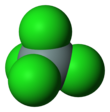
Back Silikontetrachloried Afrikaans رباعي كلوريد السيليكون Arabic تتراکولورید سیلیسیوم AZB Chlorid křemičitý Czech Tetrachlorsilan German Tetracloruro de silicio Spanish سیلیسیم تتراکلرید Persian Piitetrakloridi Finnish Tétrachlorure de silicium French सिलिकॉन टेट्राक्लोराइड Hindi
|
| |||
| Names | |||
|---|---|---|---|
| IUPAC name
Tetrachlorosilane
| |||
| Other names
Silicon tetrachloride
Tetrachlorosilane | |||
| Identifiers | |||
3D model (JSmol)
|
|||
| ChemSpider | |||
| ECHA InfoCard | 100.030.037 | ||
| EC Number |
| ||
PubChem CID
|
|||
| RTECS number |
| ||
| UNII | |||
| UN number | 1818 | ||
CompTox Dashboard (EPA)
|
|||
| |||
| |||
| Properties | |||
| SiCl4 | |||
| Molar mass | 169.90 g/mol | ||
| Appearance | Colourless liquid | ||
| Density | 1.483 g/cm3 | ||
| Melting point | −68.74 °C (−91.73 °F; 204.41 K) | ||
| Boiling point | 57.65 °C (135.77 °F; 330.80 K) | ||
| Reacts to form silica | |||
| Solubility | soluble in benzene, toluene, chloroform, ether[1] | ||
| Vapor pressure | 25.9 kPa at 20 °C | ||
| −88.3·10−6 cm3/mol | |||
| Structure | |||
| Tetrahedral | |||
| 4 | |||
| Thermochemistry | |||
Std molar
entropy (S⦵298) |
240 J·mol−1·K−1[2] | ||
Std enthalpy of
formation (ΔfH⦵298) |
−687 kJ·mol−1[2] | ||
| Hazards | |||
| GHS labelling: | |||

| |||
| Warning | |||
| H315, H319, H335 | |||
| P261, P264, P271, P280, P302+P352, P304+P340, P305+P351+P338, P312, P321, P332+P313, P337+P313, P362, P403+P233, P405, P501 | |||
| NFPA 704 (fire diamond) | |||
| Safety data sheet (SDS) | ICSC 0574 MSDS | ||
| Related compounds | |||
Other anions
|
Silicon tetrafluoride Silicon tetrabromide Silicon tetraiodide | ||
Other cations
|
Carbon tetrachloride Germanium tetrachloride Tin(IV) chloride Titanium tetrachloride | ||
Related chlorosilanes
|
Chlorosilane Dichlorosilane Trichlorosilane | ||
| Supplementary data page | |||
| Silicon tetrachloride (data page) | |||
Except where otherwise noted, data are given for materials in their standard state (at 25 °C [77 °F], 100 kPa).
| |||
Silicon tetrachloride or tetrachlorosilane is the inorganic compound with the formula SiCl4. It is a colorless volatile liquid that fumes in air. It is used to produce high purity silicon and silica for commercial applications. It is a part of the chlorosilane family.
- ^ P. W. Schenk (1963). "Phosphorus(V) fluoride". In G. Brauer (ed.). Handbook of Preparative Inorganic Chemistry, 2nd Ed. Vol. 1. NY, NY: Academic Press. pp. 282–683.
- ^ a b Zumdahl, S. S. (2009). Chemical Principles (6th ed.). Houghton Mifflin. p. A22. ISBN 978-0-618-94690-7.
© MMXXIII Rich X Search. We shall prevail. All rights reserved. Rich X Search


